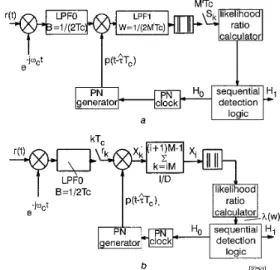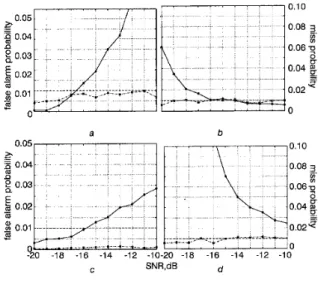5
Fig. 1 shows, for QPSK and
v
= 4, a comparison between the time-discrete observation model adopted in this Letter, which holds for slow fading, and a time continuous observation, which correctly models fast fading channels as well. In fact, in a flat fad- ing channel, a fast time variation causes inter symbol interference (ISI) in the observation. This comparison shows that this IS1 has almost no influence on the receiver performance for slowly fading channels (B, = 0.005, 0.01, 0.05). For fast fading (B, = O.l), the difference in performance between the two models is still moder- ate, even for EJN, = 40dB.This work was also presented at the 32nd Conference on Inf‘or- mation Sciences and Systems (CISS ’98), Princeton University, Princeton, NJ, USA.
Acknowledgment: This work was supported by Minister0 dell’Uni- versita e della Ricerca Scientifca e Tecnologica, Italy and Con- siglio Nazionale delle Ricerche, Italy.
0 IEE 1998
Electronics Letters Online No: 19980959
G. Colavolpe, P. Castoldi and R. Raheli (Dipartimento di Ingegneria dell’lnformazione, Universita di Parma, Vide delle Scienze, 43100 Parma, Italy)
E-mail: castoldi@tlc.unipr.it
18 May I998
References
1 CLARKE, R.: ‘A statistical theory of mobile radio reception’, Bell Syst. Tech. J . , 1968, 47, pp. 957-1000
2 YU, x., and PASUPATHY, s : ‘Innovations-based MLSE for Rayleigh fading channels’, IEEE Trans. Commun., 1995, 43, part 111, pp. 15341544
3 MAKRAKIS, D., MATHIOPOULOS, P., and BOURAS, D.: ‘Optimal decoding of coded PSK and QAM signals in correlated fast fading channels and AWGN: a combined envelope, multiple differential and coherent detection approach’, IEEE Trans. Commun., 1994, 42, (l), pp. 63-75
4 KONG, H., and SHWEDYK, E.: ‘Detection of amplitude-phase
modulated signals over frequency nonselective Rayleigh fading channels with adaptive symbol-aided channel estimation’. Veh. Tech. Conf. (VTC ’96), 1996, pp. 983-987
Noncoherent SPRT-based acquisition
scheme for DSSS
Jia-Chin
Lin
A noncoherent sequential PN code acquisition scheme is proposed. The out-of-phase and on-phase sequences are properly modelled to avoid sigmfkantly high error probabilities occurring with the conventional SPRT-based acquisition. In addition, data modulation and frequency offset can be effectively overcome using this technique.
Introduction: By modelling the acquisition problem as testing between two hypotheses, a sequential test technique under coher- ent demodulation environments has been proposed and analysed [l]. However, it is, in practice, almost impossible to achieve coher- ent demodulation, because the signal-to-noise ratio (SNR) before despreading is very low. Several sequential probability ratio tests (SPRTs) designed for P N code acquisition under noncoherent demodulation environments have also been discussed [2 - 41, but
under the assumption that the out-of-phase sequence could be modelled as a zero sequence. However, such an assumption may not be very practical, for reasons explained in the following. The modified technique proposed here is then described and simulated.
M‘Tc ... . _ ratio I -jwct e PN generator logic a 1 - 1 b /275411
Fig. 1 Conventional and proposed noncoherent sequential acquisition techniques
a Conventional b Proposed
Conventional sequential acquisition techniques: The conventional noncoherent acquisition technique based on SPRT is shown in Fig. la. The received signal is first down-converted by means of a noncoherent local carrier, and then passed through a lowpass filter LPFO. The resulting signal is then cross-correlated with the local code sequence. The cross-correlation signal is passed through a second lowpass filter LPF1. The output of LPFl is then fed into an envelope detector. The envelope samples S, are obtained by sampling the output of the envelope detector at a rate low enough (i.e. 1IM’TJ that the samples can be considered to be independent. Finally, the envelope samples enter the likelihood
ratio calculator
and the sequential detection logic.However, in such a structure, the lowpass filter LPFl may be very difficult to design. If its bandwidth is too wide, say W = l/ 2T,, the cross-correlation of the incoming and the local sequences under the out-of-phase condition cannot be reduced at all. This leads to a high false alarm probability. The bandwidth W of this filter must be narrow enough, e.g. W << l/2Tc, to reject residual cross-correlation under the out-of-phase conditions, because the likelihood ratio calculator and sequential detection logic are designed based on the assumption that the out-of-phase sequence can be modelled as a zero sequence here. Conversely, the SPRT algorithm is derived with the assumption that the samples entering the likelihood ratio calculator are sufficiently spaced, e.g. at MT,
where
M
>> 1, and can be considered independent, but with thatassumption the carrier frequency offset and data modulation effects could possibly change the statistics of the on-phase sequence significantly and lead to a high miss probability. There- fore, it may be very difficult in practice to design and implement the conventional noncoherent sequential acquisition scheme in Fig. l a .
Proposed noncoherent sequential acquisition technique: The nonco- herent sequential acquisition technique proposed in this Letter is shown in Fig. lb. The received signal is down-converted noncoher- ently, passed through a lowpass filter (LPFO) and then sampled at the chip rate to generate the baseband received sample stream r,
rk = F c i ( ( k - T ) T , ) p ( ( k - T ) T c ) e j g k
+
n k (1) Tcwhere 0, = 2xAfkT,+O,, and n, is the noise sample. The resulting sequence, {r,'}, is cross-correlated with the local code sequence p((k - Z)T,), where .E is the local PN code phase offset and is an
integer; the samples {&'} are then generated as
Xk = Y,'d((k - T)Tc)eJ8h
+
NL ( 2 )where Y i = .\j(Ec/Tc)p((k - z)T,)p((k - t')T,) and
4:
= nk.p((k -2)TJ. In eqn. 2, the sequence {YL} provides the information desired to detect whether the received and the local PN sequences are synchronised. It is corrupted by the data modulation effect, d((k - z)T,), and the carrier frequency offset effect, e i e k . It can be
shown that the noise term N i is a complex Gaussian random var- iable with zero mean and the same variance as n,. The cross-corre- lation samples,
Xi,
are integrateadumped (ID) for each M (non- overlapped) samples to generate the I/D cross-correlation samplesx;:
(z+l)M-1 X , = X ; = Yiejg(j+
N , (3) k = i M where ( i + l ) M - l (z+l)M-1y, = y,',J(a*wk'l',) ancl N , = Nil
k = z M k=zM
Based on the model of the partial correlation of PN sequences
[I], the acquisition problem can be considered as the testing of a composite hypothesis H , against a simple alternative HI by means of the envelopes of the I/D cross-correlation samples,
4.
Hence, the desired informationsequence, {y},
in eqn. 3 can be m-odelled either by the constant Y1=fi
. M f o r H, (i.e.z
= 2 ) or Y o 5fu . M for H, (i.e.z
# t'), wheref, = IlC,"=, eAznAfkr~)ll is a factor intro- duced by the carrier frequency offset which approaches 1 as Mdecreases, andf, = 0.5 is used here because it corresponds to the worst-case correlation under synchronisation for the case when- ever the chip timing is unknown and the local PN generator is updated by for each H, claimed. Based on the model of
y,
and after some manipulation, the envelope samples, IlX;ll, of the I/Dcorrelation samples can be described by iid Rician random varia- bles with parameter either Y' for
Hi
or Y o for H,. The log-likeli- hood ratio for the ith envelope sample, ri, is thenand we will consider the sequential test using the statistic
h(w)
=&"=, Z,. The SPRT is described by
*
Hl+
take another envelope sampleX(w)
( I B
5'4 =+Ho (5)E ( A , B )
where the threshold levels, A and B, are given [3], so that the test can achieve the false alarm probability a and the miss probability
1
-p.
Simulation results: The false alarm and miss probabilities of the proposed and conventional sequential acquisition techniques are shown in Fig. 2. The false alarm and miss probabilities in the case of a carrier frequency offset A/(l/TJ = 0.025 (i.e. Aj7(1/7J = 3.2 for processing gain = 128), M' = 4 for the conventional technique and M = 4 for the proposed technique are plotted in Fig. 2a and
ELECTRONICS LETTERS 25th June 1998 Vol.
34
b, while those under the same condition except for M' = 8/M = 8 are shown m Fig. 2c and d. From Fig. 2a, the false alarm proba- bility of the conventional SPRT is significantly higher than the given false alarm probability when M' is small, e.g. M = 4, because the bandwidth, W = 1/2MTc, of LPFl is too wide to reject the residual cross-correlation under the out-of-phase condi- tions, but the out-of-phase sequences were incorrectly modelled as a zero sequence. For a larger M value, e.g. M' = 8, the false alarm probability of the conventional technique is reduced (Fig. 2c), because the narrower bandwidth of LPFl can reject more residual cross-correlation; however, such a narrow bandwidth may accumulate the effects of the carrier frequency offset and then change the statistics of the on-phase sequence. This may lead to a much higher miss probability (Fig.
24.
From Fig. 2, no matter how the bandwidth of LPFl i s chosen, the error probabilities (false a l a d m i s s probabilities) of the conventional technique can- not be accepted; no such problem occurs with the proposed tech- nique. 0 10 008 3-
U) 0 06 2 0.04 g 0 m --
0.02c!
0 a ba
0 0 4 m 6 . .Ll Q 003.-
g
0.02: 0 2 K l . B_ _
'-A
'-;2._ -l!-20 . -18 -16 -14 -12 -10 0 .. .. - - - - C SNR,dB dFig. 2 False alarm and miss probabilities for conventional and proposed
SPRT when Ajl(l/Tc) = 0.025 and desired error probability is -0- conventional - .
*
. - proposed a False alarm; M', M = 4 b Miss; M', A4 = 4 c False alarm; M', M = 8 d Miss; M', M = 8 desired _ _ _ _Conclusion: In this Letter, a noncoherent sequential PN code acquisition technique is proposed. The out-of-phase sequence has been modelled as the upper bound of the cross-correlation between any two non-synchronised sequences, and the on-phase sequence has been modified by a factor caused by the carrier fre- quency offset effect to avoid significantly high error probabilities occurring with the conventional SPRT-based acquisition tech- nique.
0 IEE 1998
Electronics Letters Online No: 19980957
Jia-Chin Lin (Department of Electrical Engineering, Rm 531, National Taiwan University, 106-1 7 Taipei, Taiwan, Republic of China) E-mail: jiachin@speech.ee.ntu.edu.tw
6 May 1998
References
1 LEE, Y.-H., and TANTARATANA, s.: 'Sequential acquisition o f PN sequences for D S i S S communications: Design and performance', IEEE J. Sel. Areas Commun., 1992, pp. 750-759
2 SIMON, M., OMURA, .I., SCHOLTZ, R., and LIVITT, K.: 'Spread spectrum communication' vol. 111, (Computer Science Press, Rockville, MD, 1985)
3 WALD, A.: 'Sequential analysis' (Wiley, New York, 1947) 4 su, Y.-T., and WEBER, c.L.: 'A class o f sequential tests and its
applications', IEEE Trans. Conzmun., 1990, 38, (2), pp. 165-171

